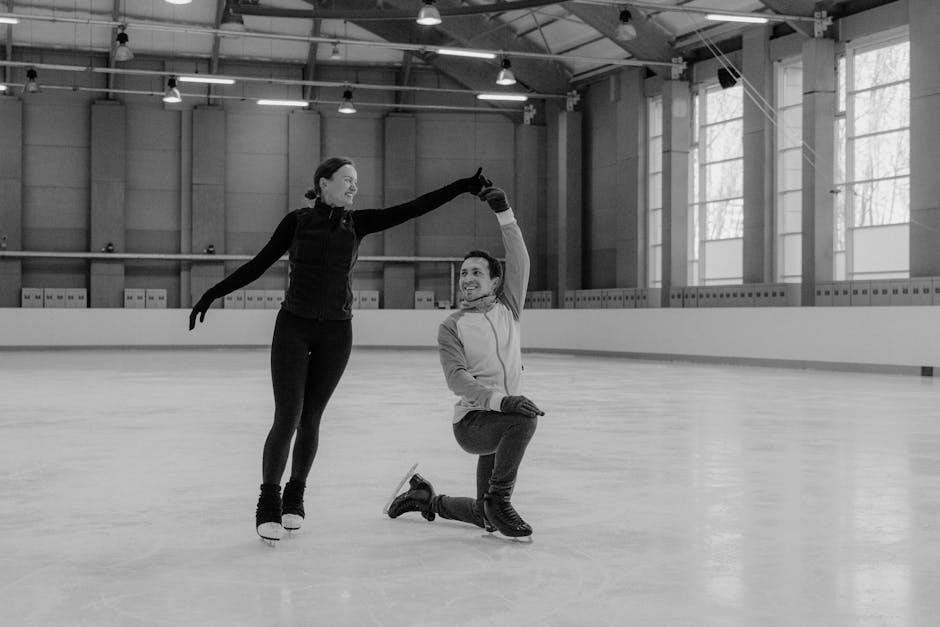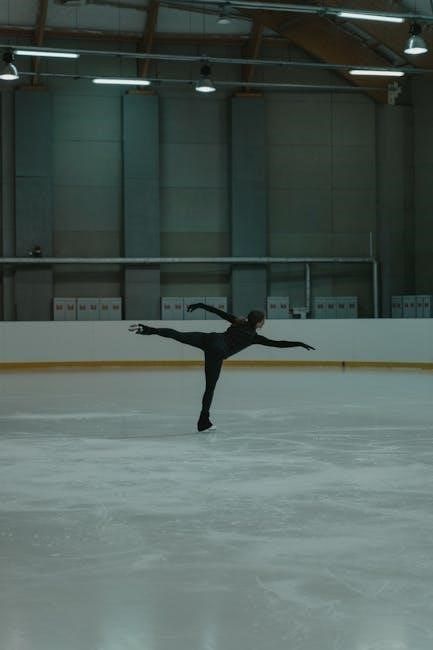Polyvagal Theory, developed by Stephen Porges, explains how the autonomic nervous system responds to safety and threats․ It introduces three branches: ventral vagal, sympathetic, and dorsal vagal, which guide emotional and physiological reactions․ This framework is widely applied in therapy to enhance emotional regulation and resilience, offering practical exercises for managing stress and trauma․
Overview of the Polyvagal Theory
Polyvagal Theory, developed by Stephen Porges, explores how the autonomic nervous system (ANS) regulates responses to safety, danger, and life-threatening situations․ The theory identifies three evolutionary hierarchies of the ANS: the ventral vagal complex (associated with social engagement and safety), the sympathetic nervous system (linked to fight-or-flight responses), and the dorsal vagal complex (connected to immobilization and collapse)․ These systems operate in a hierarchy, with the ventral vagal being the most evolved and the dorsal vagal the most primitive․ The theory explains how individuals cycle through these states based on perceptions of safety or threat, influencing emotional, behavioral, and physiological reactions․ This framework is widely used in trauma recovery, anxiety treatment, and emotional regulation practices․
The Three Branches of the Autonomic Nervous System
The Polyvagal Theory identifies three branches of the autonomic nervous system (ANS), each with distinct roles in responding to safety, danger, and life-threatening situations․ The ventral vagal complex is the most evolved, facilitating social engagement and connection in safe environments․ The sympathetic nervous system activates the “fight-or-flight” response when danger is detected․ The dorsal vagal complex is the most primitive, triggering immobilization or collapse in life-threatening situations․ These branches operate hierarchically, with the ventral vagal system taking precedence when safety is perceived․ Understanding these branches is crucial for developing exercises that promote emotional regulation, resilience, and therapeutic interventions, especially in trauma recovery and anxiety management․

Principles of Polyvagal Theory
Polyvagal Theory emphasizes the role of the vagus nerve in regulating emotional and physiological states․ It highlights how the autonomic nervous system prioritizes safety, influencing social engagement, fight-or-flight, and immobilization responses․ These principles guide therapeutic exercises to enhance resilience and emotional well-being․
The Role of the Vagus Nerve in Emotional Regulation
The vagus nerve plays a crucial role in emotional regulation by influencing the body’s physiological responses to safety and threats․ As the tenth cranial nerve, it connects the brain to various organs, modulating heart rate, breathing, and digestion․ According to Polyvagal Theory, the vagus nerve helps differentiate between safe and dangerous environments, triggering appropriate responses․ When we feel safe, the ventral vagal branch promotes social engagement and calmness․ In threatening situations, the sympathetic nervous system activates a fight-or-flight response, while the dorsal vagal branch may lead to immobilization․ Exercises targeting the vagus nerve, such as controlled breathing and vocal practices, can enhance emotional regulation and resilience, fostering a sense of safety and well-being․ This understanding is central to Polyvagal Theory’s practical applications in therapy and stress management․
Understanding Safety and Threat Responses
The Polyvagal Theory emphasizes how the autonomic nervous system (ANS) evaluates safety and threats through a hierarchical response system․ The ventral vagal complex prioritizes safety, enabling social engagement and relaxation․ When safety is uncertain, the sympathetic nervous system activates a fight-or-flight response․ If both fail, the dorsal vagal complex triggers immobilization, a survival strategy for extreme danger․ Recognizing these responses helps individuals understand their emotional reactions and develop strategies to return to a state of safety․ Exercises like grounding techniques and self-compassion practices can recalibrate the ANS, fostering resilience and emotional balance․ This understanding is essential for applying Polyvagal Theory in therapy and daily life to manage stress and improve well-being․

Exercises Based on Polyvagal Theory
These exercises include breathing techniques, grounding practices, vocal exercises, and self-compassion to effectively regulate the nervous system and enhance emotional stability and resilience․
Tracking Bodily Sensations
Tracking bodily sensations is a foundational exercise in Polyvagal Theory, helping individuals tune into their autonomic nervous system responses․ By regularly checking in with physical sensations like tightness, relaxation, or numbness, one can assess their current state: ventral vagal (safe), sympathetic (fight/flight), or dorsal vagal (freeze)․ This practice enhances interoception, or the ability to sense internal bodily states, which is key to emotional regulation․ Start by pausing throughout the day to notice areas of tension or ease, such as a racing heart or relaxed shoulders․ Over time, this awareness allows for earlier detection of stress responses and the opportunity to employ regulatory strategies․ Regular practice can improve resilience and emotional balance by fostering greater body-mind connection․ For guidance, refer to PDF resources that provide structured exercises and reflection prompts․
Breathing Techniques for Nervous System Regulation

Breathing techniques are a powerful tool in Polyvagal Theory exercises, helping to regulate the autonomic nervous system․ Slow, deep breathing can activate the parasympathetic response, fostering a state of safety and calm․ Techniques like diaphragmatic breathing and box breathing are commonly used to shift from sympathetic (fight/flight) or dorsal vagal (freeze) states to a ventral vagal (safe) state․ These practices involve focused inhalation, exhalation, and pauses to create a rhythmic pattern that soothes the nervous system․ Regular use of these exercises can reduce stress, improve emotional resilience, and enhance overall well-being․ PDF guides often include step-by-step instructions and visual aids to help individuals master these breathing practices effectively․
Vocal Exercises to Enhance Safety
Vocal exercises are a key component of Polyvagal Theory practices, designed to enhance feelings of safety and connection․ Techniques such as humming, toning, and resonant speaking can stimulate the vagus nerve, promoting a parasympathetic response․ These exercises often involve using the voice to create vibrations that soothe the nervous system, fostering a sense of grounding and calm․ By engaging the ventral vagal complex, vocal practices can help individuals shift from states of threat to safety․ Many PDF guides provide step-by-step instructions for these exercises, emphasizing their role in building resilience and improving social engagement․ Regular practice can lead to increased emotional regulation and a stronger sense of safety in daily life․
Grounding Techniques for Emotional Stability
Grounding techniques are essential in Polyvagal Theory exercises to help individuals regain emotional stability by reconnecting with their present environment․ These practices, often detailed in PDF guides, focus on sensory awareness to shift the nervous system from a state of threat to safety․ Common exercises include the “5-4-3-2-1” method, where one identifies five things they can see, four they can touch, three they can hear, two they can smell, and one they can taste․ These activities stimulate the ventral vagal complex, promoting a sense of calm and reducing anxiety․ Regular grounding practice enhances resilience, allowing individuals to better navigate stressful situations with emotional balance and clarity․
Self-Compassion Practices

Self-compassion practices, as outlined in Polyvagal Theory exercises, play a crucial role in fostering emotional stability and resilience․ These exercises, often detailed in PDF guides, encourage individuals to cultivate kindness and understanding toward themselves, especially during distress․ Techniques such as loving-kindness meditation, journaling, or affirmations help activate the ventral vagal complex, promoting a sense of safety and connection․ By integrating self-compassion into daily routines, individuals can better regulate their nervous system, reducing feelings of shame or anxiety․ Regular practice enhances emotional resilience, allowing for a more compassionate response to challenges and fostering a deeper connection to oneself․ These exercises are particularly beneficial for those recovering from trauma or experiencing chronic stress․

Applications of Polyvagal Theory in Therapy
Polyvagal Theory informs therapeutic approaches to trauma, anxiety, and social engagement challenges․ Techniques like vagal exercises and mindfulness help regulate the nervous system, fostering emotional resilience․
Using Polyvagal Exercises in Trauma Recovery
Polyvagal Theory provides effective strategies for trauma recovery by focusing on the autonomic nervous system’s response to safety and threat․ Grounding techniques and breathing exercises help individuals regain control over physiological responses, reducing hyperarousal and promoting safety․ These interventions benefit trauma survivors by empowering them to manage triggers and improve emotional regulation․ Self-compassion practices enhance resilience, aiding individuals in navigating distressing memories․ Consistent practice leads to long-term improvements in nervous system functioning, fostering security and well-being․ These methods offer a holistic approach to healing trauma when incorporated into therapy․
Integrating Polyvagal Theory into Anxiety Treatment
Polyvagal Theory offers valuable insights for addressing anxiety by focusing on the autonomic nervous system’s role in emotional regulation․ By identifying states of safety, danger, and life threat, individuals can better understand their anxiety responses․ Techniques like diaphragmatic breathing and grounding exercises help activate the parasympathetic nervous system, promoting relaxation․ Vocal exercises, such as humming, can enhance vagal tone, reducing anxiety symptoms․ These strategies empower individuals to shift from hyperarousal to a ‘safe and social’ state, improving emotional resilience․ Consistent practice of these exercises can lead to long-term reductions in anxiety, fostering a greater sense of calm and well-being․
Case Studies of Polyvagal Theory in Practice
Case studies demonstrate the practical application of Polyvagal Theory in real-world scenarios․ For instance, a client with chronic anxiety learned to recognize their autonomic responses, shifting from a state of hyperarousal to safety through breathing exercises․ Another case involved a trauma survivor who, by practicing vocal toning and grounding techniques, reduced symptoms of hypervigilance․ These examples highlight how Polyvagal-informed interventions can empower individuals to regulate their nervous system and improve emotional resilience․ Such case studies illustrate the theory’s effectiveness in helping individuals reclaim a sense of safety and connection, fostering meaningful behavioral and emotional changes․

Benefits of Polyvagal Theory Exercises

Polyvagal exercises enhance emotional balance, reduce anxiety, and foster resilience by regulating the nervous system, promoting safety and connection for overall well-being․
Improving Emotional Regulation
Polyvagal exercises are highly effective for enhancing emotional regulation by training the nervous system to respond adaptively to stress․ These practices help individuals develop awareness of their physiological states, allowing them to intervene early when feelings of anxiety or overwhelm arise․ By strengthening the connection between the vagus nerve and the brain, exercises like deep breathing, grounding techniques, and vocal practices can calm the nervous system․ This leads to better management of emotions, reduced reactivity, and increased resilience․ Over time, consistent practice fosters a greater sense of safety and control, enabling individuals to navigate challenging situations with more ease and balance․ This improved regulation enhances overall emotional well-being and daily functioning․
Enhancing Social Engagement
Polyvagal Theory exercises play a crucial role in enhancing social engagement by activating the ventral vagal complex, the nervous system’s “social engagement” branch․ Practices such as vocal toning, mindful listening, and prosocial movements foster a sense of safety and connection․ These exercises strengthen the ability to read and respond to social cues, improving communication and empathy․ By cultivating a calm and regulated nervous system, individuals can engage more authentically in relationships, reducing feelings of isolation․ Regular practice also enhances emotional attunement, making interactions more meaningful and collaborative․ This increased capacity for connection supports personal and professional relationships, fostering a deeper sense of community and well-being․ Over time, these exercises can transform how individuals navigate social dynamics with confidence and ease․
Building Resilience to Stress
Polyvagal Theory exercises are designed to strengthen the body’s ability to handle stress by enhancing nervous system adaptability․ By practicing techniques like grounding, mindful breathing, and self-compassion, individuals can better regulate their stress responses․ These exercises help shift the nervous system from a state of hypervigilance or shutdown to a state of safety and balance․ Over time, this builds resilience, allowing individuals to recover more quickly from stressful events․ Improved emotional regulation and increased awareness of bodily sensations also empower people to navigate challenges with greater ease․ Regular practice fosters a sense of control and confidence, making it easier to manage stress in both personal and professional settings․

Challenges and Considerations
Polyvagal Theory exercises require consistency and individualized approaches, as responses vary․ Some practices may trigger past trauma, emphasizing the need for professional guidance and a safe environment․
Potential Misapplication of Exercises
Polyvagal Theory exercises, if misapplied, can lead to unintended negative effects․ Using techniques without proper understanding or professional guidance may exacerbate anxiety or trigger past traumas․ Exercises might be applied in inappropriate contexts or without personalization, failing to address individual needs or trauma histories․ Relying solely on PDF guides without therapeutic support can result in ineffective or harmful outcomes․ Additionally, exercises may be used in settings where personalized feedback is lacking, increasing the risk of distress․ Proper training and professional supervision are crucial to ensure exercises are applied safely and effectively, avoiding potential misapplication and its consequences․
Individual Differences in Response
Individual differences play a significant role in how people respond to Polyvagal Theory exercises․ Each person’s unique life experiences, trauma history, and autonomic nervous system sensitivity influence outcomes․ Some may find certain exercises deeply grounding, while others might feel overwhelmed or triggered․ Genetic predispositions, attachment styles, and current stress levels also shape responses․ For example, vocal exercises may help one person feel safe but could be activating for another․ Recognizing these differences is crucial for tailoring exercises to individual needs․ Without personalized approaches, exercises may not yield the desired effects or could even exacerbate distress․ This highlights the importance of adaptability and professional guidance when implementing Polyvagal-based practices․
The Importance of Consistency in Practice
Consistency is crucial for maximizing the benefits of Polyvagal Theory exercises․ Regular practice helps train the autonomic nervous system, enhancing its ability to regulate emotions and respond to stress․ Over time, this consistency builds resilience, allowing individuals to navigate challenging situations more effectively․ Without regular engagement, the positive effects may diminish, making it harder to maintain emotional stability․ Incorporating exercises into daily routines, even in small amounts, fosters long-term improvements in nervous system function․ By prioritizing consistency, individuals can experience sustained growth in their emotional and physiological well-being․

Resources for Polyvagal Theory Exercises
Explore resources for Polyvagal Theory exercises, including PDF guides, online courses, and books․ These materials offer practical exercises and deepen understanding of nervous system regulation․
Recommended PDF Guides and Worksheets
Polyvagal Theory exercises PDF guides and worksheets are widely available online, offering structured practices to enhance nervous system regulation․ Many official websites and therapist portals provide downloadable resources, including exercises like tracking bodily sensations, breathing techniques, and vocal exercises․ These guides often include printable worksheets for mapping personal responses to safety and threat cues․ Worksheets may focus on grounding techniques, self-compassion practices, and creating personalized safety plans․ Some PDFs also offer reflective exercises to explore emotional responses and resilience-building activities․ When using these resources, it’s helpful to work with a therapist or independently to tailor exercises to individual needs․ Consistency in practice is key to experiencing benefits like improved emotional regulation and stress resilience․
Online Courses and Tutorials
Online courses and tutorials on Polyvagal Theory exercises are an excellent way to deepen understanding and practice․ Platforms like Coursera, Udemy, and specialized therapy websites offer structured programs․ These courses often include video lessons, downloadable PDF guides, and interactive exercises․ Many focus on practical applications, such as nervous system regulation, emotional resilience, and social engagement․ Tutorials may cover breathing techniques, vocal exercises, and grounding practices, with step-by-step instructions․ Some courses are led by experts in the field, ensuring high-quality instruction․ They also provide forums for discussion and feedback, enhancing the learning experience․ These resources are ideal for both individuals and professionals seeking to integrate Polyvagal Theory into their lives or practices․
Books on Polyvagal Theory and Practices
Books on Polyvagal Theory provide in-depth exploration of its principles and practical exercises․ Notable titles include The Polyvagal Theory by Stephen Porges and The Polyvagal Path to Safety by Deb Dana․ These books offer comprehensive insights into understanding the autonomic nervous system and its role in emotional regulation․ Many are available as PDFs, making them accessible for easy reading․ They include detailed exercises, case studies, and real-world applications, helping readers integrate Polyvagal Theory into daily life․ Whether for personal growth or professional development, these books are invaluable resources for anyone seeking to enhance emotional resilience and improve relationships through Polyvagal-informed practices․
Polyvagal Theory offers a groundbreaking framework for understanding and managing the autonomic nervous system, providing practical tools for emotional regulation and resilience․ By focusing on the vagus nerve and its role in safety and threat responses, individuals can harness exercises like breathing techniques, vocal practices, and grounding methods to enhance their well-being․ Regular practice of these exercises, as outlined in resources like PDF guides, can lead to improved emotional stability, stronger social connections, and a greater ability to navigate life’s challenges․ Consistency is key, and integrating these practices into daily life can foster long-term positive change․ Embracing Polyvagal Theory is a powerful step toward reclaiming emotional balance and living a more fulfilling life․
